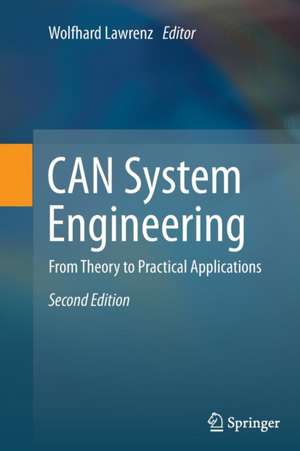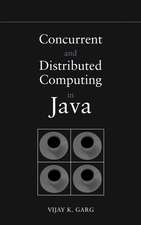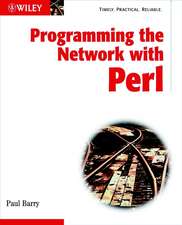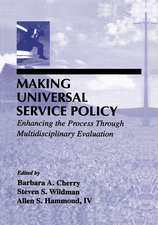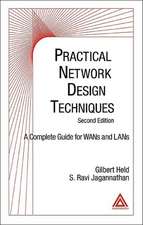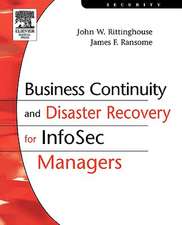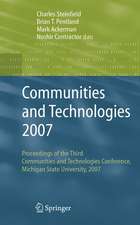CAN System Engineering: From Theory to Practical Applications
Editat de Wolfhard Lawrenzen Limba Engleză Paperback – 17 dec 2013
| Toate formatele și edițiile | Preț | Express |
|---|---|---|
| Paperback (1) | 1270.11 lei 43-57 zile | |
| SPRINGER LONDON – 17 dec 2013 | 1270.11 lei 43-57 zile | |
| Hardback (1) | 1276.54 lei 43-57 zile | |
| SPRINGER LONDON – 17 dec 2013 | 1276.54 lei 43-57 zile |
Preț: 1270.11 lei
Preț vechi: 1587.64 lei
-20% Nou
Puncte Express: 1905
Preț estimativ în valută:
243.07€ • 252.83$ • 200.66£
243.07€ • 252.83$ • 200.66£
Carte tipărită la comandă
Livrare economică 14-28 aprilie
Preluare comenzi: 021 569.72.76
Specificații
ISBN-13: 9781447168027
ISBN-10: 144716802X
Pagini: 353
Ilustrații: XXV, 353 p. 186 illus.
Dimensiuni: 155 x 235 x 20 mm
Greutate: 0.53 kg
Ediția:2nd ed. 2013
Editura: SPRINGER LONDON
Colecția Springer
Locul publicării:London, United Kingdom
ISBN-10: 144716802X
Pagini: 353
Ilustrații: XXV, 353 p. 186 illus.
Dimensiuni: 155 x 235 x 20 mm
Greutate: 0.53 kg
Ediția:2nd ed. 2013
Editura: SPRINGER LONDON
Colecția Springer
Locul publicării:London, United Kingdom
Descriere
The controller area network (CAN) microcontroller communication protocol is now ubiquitous in a staggeringly wide range of transportation and industrial control applications.
This fully revised and updated new edition addresses the various challenges and open questions relating to CAN communication networks. Opening with a short introduction into the fundamentals of CAN, the book then examines the problems and solutions for the physical layout of networks, including EMC issues and topology layout. Additionally, a discussion of quality issues with a particular focus on test techniques is presented. Each chapter features a collection of illuminating insights and detailed technical information supplied by a selection of internationally-regarded experts from industry and academia.
Topics and features: presents thorough coverage of architectures, implementations and application of CAN transceiver, data link layer and so-called higher layer software; explains CAN EMC characteristics and countermeasures, as well as how to design CAN networks; demonstrates how to practically apply and test CAN systems; includes examples of real networks from diverse applications in automotive engineering, avionics, and home heating technology; includes a glossary of abbreviations, and a useful bibliography.
This comprehensive text will be an invaluable guide/reference for electronic engineers working with industrial control systems.
This fully revised and updated new edition addresses the various challenges and open questions relating to CAN communication networks. Opening with a short introduction into the fundamentals of CAN, the book then examines the problems and solutions for the physical layout of networks, including EMC issues and topology layout. Additionally, a discussion of quality issues with a particular focus on test techniques is presented. Each chapter features a collection of illuminating insights and detailed technical information supplied by a selection of internationally-regarded experts from industry and academia.
Topics and features: presents thorough coverage of architectures, implementations and application of CAN transceiver, data link layer and so-called higher layer software; explains CAN EMC characteristics and countermeasures, as well as how to design CAN networks; demonstrates how to practically apply and test CAN systems; includes examples of real networks from diverse applications in automotive engineering, avionics, and home heating technology; includes a glossary of abbreviations, and a useful bibliography.
This comprehensive text will be an invaluable guide/reference for electronic engineers working with industrial control systems.
Cuprins
CAN Basic Architectures
Maria Fischer, Florian Hartwich, Robert Hugel, and Wolfhard Lawrenz
Physical Layer
Cornelius Butzkamm, Bernd Elend, Thorsten Gerke, Magnus-Maria Hell, Ursula Kelling, Günter Kircher, Bernd Koerber, Wolfhard Lawrenz, Kurt Mueller, Christian Schmitz, Radoslaw Watroba, and Rolf Weber
Data Link Layer Implementation
Florian Hartwich, Ursula Kelling, Vamsi Krishna, Wolfhard Lawrenz, Roland Lieder, and Peter Riekert
Higher Level Protocols
Gangolf Feiter, Lars-Berno Fredriksson, Karsten Hoffmeister, Joakim Pauli, and Holger Zeltwanger
Applications
Markus Brockmann, Nathalie Courmont, Ralph Knüppel, Gabriel Leen, Guenter Reichart, and Christian Schmid
Testing
Federico Cañas, Maria Fischer, Stefan Krauß, Lothar Kukla, Wolfhard Lawrenz, and Nils Obermoeller
Maria Fischer, Florian Hartwich, Robert Hugel, and Wolfhard Lawrenz
Physical Layer
Cornelius Butzkamm, Bernd Elend, Thorsten Gerke, Magnus-Maria Hell, Ursula Kelling, Günter Kircher, Bernd Koerber, Wolfhard Lawrenz, Kurt Mueller, Christian Schmitz, Radoslaw Watroba, and Rolf Weber
Data Link Layer Implementation
Florian Hartwich, Ursula Kelling, Vamsi Krishna, Wolfhard Lawrenz, Roland Lieder, and Peter Riekert
Higher Level Protocols
Gangolf Feiter, Lars-Berno Fredriksson, Karsten Hoffmeister, Joakim Pauli, and Holger Zeltwanger
Applications
Markus Brockmann, Nathalie Courmont, Ralph Knüppel, Gabriel Leen, Guenter Reichart, and Christian Schmid
Testing
Federico Cañas, Maria Fischer, Stefan Krauß, Lothar Kukla, Wolfhard Lawrenz, and Nils Obermoeller
Recenzii
From the book reviews:
“This edition comprises six chapters that cover the architecture, physical layer, data link implementation, higher-level protocols, applications, and testing. … Each of the six chapters provides a clear exposition of its subject. … All in all, this would be a welcome addition to one’s bookshelf and could be useful in an upper-level university course.” (J. S. Edwards, Computing Reviews, June, 2014)
“This edition comprises six chapters that cover the architecture, physical layer, data link implementation, higher-level protocols, applications, and testing. … Each of the six chapters provides a clear exposition of its subject. … All in all, this would be a welcome addition to one’s bookshelf and could be useful in an upper-level university course.” (J. S. Edwards, Computing Reviews, June, 2014)
Textul de pe ultima copertă
The controller area network (CAN) microcontroller communication protocol is now ubiquitous in a staggeringly wide range of transportation and industrial control applications.
This fully revised and updated new edition addresses the various challenges and open questions relating to CAN communication networks. Opening with a short introduction into the fundamentals of CAN, the book then examines the problems and solutions for the physical layout of networks, including EMC issues and topology layout. Additionally, a discussion of quality issues with a particular focus on test techniques is presented. Each chapter features a collection of illuminating insights and detailed technical information supplied by a selection of internationally-regarded experts from industry and academia.
Topics and features:
Prof. Dr. Wolfhard Lawrenz is the former founder and director of C&S Group GmbH. He has extensive worldwide experience and recognition in working with CAN techniques with companies ranging from automotive manufacturers and suppliers to semiconductor manufacturers, as well as international standardization committees such as ISO and SAE.
This fully revised and updated new edition addresses the various challenges and open questions relating to CAN communication networks. Opening with a short introduction into the fundamentals of CAN, the book then examines the problems and solutions for the physical layout of networks, including EMC issues and topology layout. Additionally, a discussion of quality issues with a particular focus on test techniques is presented. Each chapter features a collection of illuminating insights and detailed technical information supplied by a selection of internationally-regarded experts from industry and academia.
Topics and features:
- Presents thorough coverage of architectures, implementations and application of CAN transceiver, data link layer and so-called higher layer software
- Explains CAN EMC characteristics and countermeasures, as well as how to design CAN networks
- Demonstrates how to practically apply and test CAN systems
- Includes examples of real networks from diverse applications in automotive engineering, avionics, and home heating technology
- Includes a glossary of abbreviations, and a useful bibliography
Prof. Dr. Wolfhard Lawrenz is the former founder and director of C&S Group GmbH. He has extensive worldwide experience and recognition in working with CAN techniques with companies ranging from automotive manufacturers and suppliers to semiconductor manufacturers, as well as international standardization committees such as ISO and SAE.
Caracteristici
Presents thorough coverage of the architectures, implementations and applications of CAN transceivers, the data link layer and so-called higher layer software
Explains CAN EMC characteristics and countermeasures, as well as how to design CAN networks
Includes examples of real networks from diverse applications in automotive engineering, avionics, and home heating technology
Includes supplementary material: sn.pub/extras
Explains CAN EMC characteristics and countermeasures, as well as how to design CAN networks
Includes examples of real networks from diverse applications in automotive engineering, avionics, and home heating technology
Includes supplementary material: sn.pub/extras
